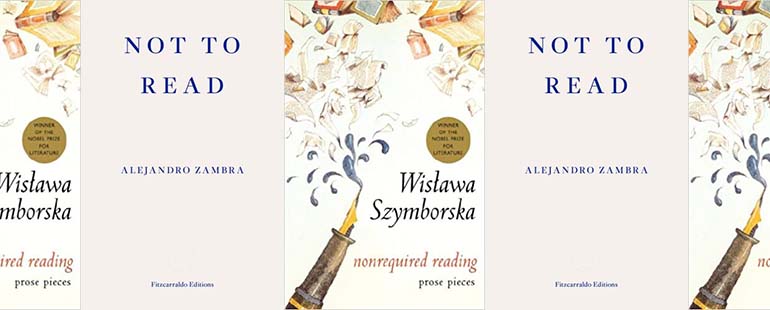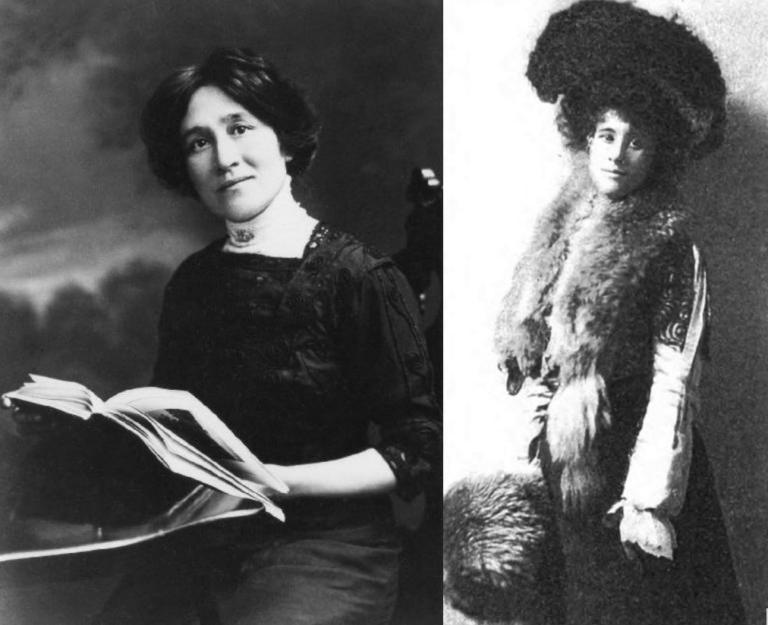The Poetry of Wislawa Szymborska and Alejandro Zambra’s Book Reviews

I
One of my favorite poems by Wislawa Szymborska starts like this:
For me the tragedy’s most important act is the sixth:
the raising of the dead from the stage’s battlegrounds
the straightening of wigs and fancy gowns
removing knives from stricken breasts,
taking nooses from lifeless necks,
lining up among the living
to face the audience.
The speaker goes on to describe how the characters all come together, the living and the dead, and even “the victim’s eyes smile at the torturer.” The show-making of theatre swells with more life than the “eternity” and “redeeming values” of the play. The curtain falls, “one hand quickly reaches for a flower,” and “one last, unseen, hand / does its duty / and grabs me by the throat.”
Szymborska’s poem is about the boundary between art and life, where art’s convincing illusion falters—a hand reaches out from under the curtain—and allows us to glimpse something moving about reality and make-believe. The hand reaching for the speaker’s throat suggests how much the gestures captivate her, and maybe how she has transgressed by witnessing these scenes. The viewer gets punished for slipping out from the suspension of disbelief; the actor clutches her and once again becomes the killer on stage.
This interest in exposed artifice and unexpected perspectives defines Szymborska’s poems (some of which have been published in Ploughshares). It also shapes Nonrequired Reading, a collection of newspaper columns she wrote for thirty years (published in Clare Cavanagh’s English translation in 2002). Her job was to review books, so she wrote sketches about books that people actually read, books “unappreciated, undiscussed, unrecommended,” books “selling out on the spot.” In her greatest column, she writes about a wall calendar. She also muses on a guide to Polish birds, a handbook on opera, a home improvement manual, a guide to wallpapering, a guide to building muscle, a survey of floristry, a history of mollusk evolutions, an introduction to French humor, Hans Christian Andersen’s Fairy Tales, comic books, and a study on buttons in literature. The books Szymborska writes about all exist on the border between art and life: filling up bookshelves, constructed by social assumptions and words, and shaping the lives of their readers—though hardly, if ever, receiving acknowledgment from critics and reviewers.
It is impossible to imagine the author of No End of Fun as a severe critic—she comes to everything as an eternal child roused by wonder. This comes through in the openings to her columns, one of which begins like this: “Why am I reading this book? I have no intention of setting up a home terrarium.” Another begins with passion: “We dream, but so carelessly, so imprecisely!” And yet another, exasperation: “It’s useless to try to describe Vermeer’s paintings in words. They’d be far better served by a quartet consisting of two violins, bassoon, and harp.” Some start with quotations, others with stories. Many with humor: “Hitchcock must have been every dietician’s nightmare.” In all of the columns Szymborska begins with variety, unexpectedness, and the momentum of interest: “I like birds for their flights and non-flights. For their diving into waters and clouds.” The column about calendars, appropriately titled “Page-Turners,” begins: “And why not say a couple of words about the kind of calendar whose pages you tear off? It’s a book, after all, and a pretty thick one, since it can’t have any fewer than 365 pages. It turns up in kiosks in editions of 3,300,000, and is thus the ultimate best-seller.”
Where does she take the reader from these launching points? Like Karl Ove Knausgaard in his Seasons essays, always elsewhere, somewhere foreign yet familiar, somewhere unexpectedly new. Each essay makes a turn, however slight, in argument, topic, or tone. This doesn’t have to be a grand epiphany—many columns end with critiques, exclamations, and jokes. In one, she turns from relief that even some opera singers cannot understand the words they sing to observations on the politics of roles: basses play fathers while sopranos play daughters and wives. She concludes: “No conclusion follows from these comments. I admire opera, which is not real life, and I admire life, which is at times a true opera.”
Sometimes, though, her writing makes a sudden turn in register that approximates the emotional ends of poems. In one column she summarizes a book that presents different theories about Neanderthals’ interactions with Homo sapiens and how they vanished. She writes how the author conducted many interviews and visited many archaeological sites. At the end of the column, Szymborska’s critique suddenly shifts: “I couldn’t find one question, though: Did the Neanderthal cry? Did his tear ducts already respond to pain, and, more important, to a wide variety of woes and miseries? He might not have been able to give them precise names—but would this come as such a shock? I have trouble with that at times myself.” Her columns and poems always open doors; they always transport, always arrive. And they are always asking questions, always interrogating our assumptions and habits. This is literature unconcerned with hierarchies, assumed images, or notions of truth—in other words, this is literature.
In the past two years—and I know many people feel this way—I have found myself drowning in the horrors of news. Coming to Szymborska feels like emerging from the sea and resting on the shore. For all of the information we read, in a startling but monotonous rhythm of reactions—scroll, lift head, politicize; scroll, lift head, laugh—the author practices a different pace and a different place to turn. She shows us how to reconsider our assumptions. This is the most important thing we can do in life and, to me, the highest use of our reason. It is also a great relief to think about what it means to be human. We are children and also individuals again. The world unveils itself before our eyes. We are no longer looking, but seeing.
II
In high school, we learned to write in the diamond format, which most book reviews use. You start with a hook, transition to the important details, then end on affirmation or rejection. The interesting, maybe unnecessary specifics make the top and bottom corners of the diamond, while the news summary and commentary fills out the middle. In the New York Times, reviewers typically start with a quote or two related to the book’s genre or subject.
If I were obeying this form while writing about Szymborska’s Nonrequired Reading, I would open with an old quotation relevant to her new work, then summarize the content, comment on a few intricacies or successes, note one or two disappointments (no book can be perfect for this reviewer, who is perfect), and conclude with a triumphant graf about the book’s originality, voice, wit, and witness to our times. Since it would be a traditional book review, it would be rejected by all newspaper editors for its length. Perhaps I would trim it for publication, and the copy editor would help reduce my paragraphs to four sentences at most, my ungrammatical rhythms to staccato pronouncements.
What else makes a book review? Adjectives, snappy-one liners. Paragraphs without transitions. Overgeneralizations and judgments. Precisely imprecise star ratings. John Updike’s guidelines include ascertaining the author’s goals, direct quotation, plot summary (not too much), and, if deeming the book a failure, pointing readers to a successful example. The review also depends on the author and venue: a magazine like The New Yorker, for example, allows the writer more space to explore a book’s ideas and techniques. The reviewer earns these inches in newspapers if they are a well-regarded novelist, like Knausgaard writing about Michel Houellebecq’s Submission (2015) or Chimamanda Ngozi Adichie about President Barack Obama’s A Promised Land (2020). In these instances, the review becomes a space to explore the reviewer’s self, an opportunity to show how their way of reading novels can illuminate a great new work for us.
Simple enough. But what about the Neanderthal’s tears? Sometimes I enjoy reviews, and their summaries guide me to books I will cherish. But why don’t I feel anything when I read them? Why do I long for something else?
In Alejandro González Iñárritu’s 2014 film Birdman, Michael Keaton’s character confronts a theater critic and seethes, “You risk nothing of yourself.” The problem with critics, artists claim, is that they don’t risk anything in their prose. A critic can hide behind formulas and an authoritative voice, behind adjectives, behind skepticism. For this reason, I admire reviews that mingle criticism with memoir, quotation with anecdote. Works that step in front of the deceit that an objective tone comes from an objective reader. Writers who come out from behind the curtain, show that their immortality has been acted, lock gazes with the dead, and reach out for the throats of the crowd.
Sarah Fay, in a 2012 essay, writes that Margaret Fuller wrote “to promote reading as a form of self-culture and self-knowledge” while Elizabeth Hardwick “approached criticism as a creative endeavor, a necessary complement to the world of art.” The best book critics set themselves against the review, instead advocating for other causes.
James Wood, the most well-known literary critic for The New Yorker and, alongside his wife, Clairre Messud, a Ploughshares guest-editor, sets a similar dialectic for his prose. Rather than moving between literature and life, he sees how the review moves between the academic and journalistic communities, speaking “about fiction as writers speak about their craft” “for a common reader” with “the hope of influencing the kind of writing that is done” by scholars. He understands literary criticism as “writing through books, not just about them,” as it “is often achieved by using the language of metaphor and simile that literature itself uses. It involves a recognition that literary criticism is unique because one has the privilege of performing it in the same medium one is describing.”
Since book critics write about works of writing, they can share the space of the artwork; they can use metaphor, can convince with images, can shake feelings from the unexpecting reader, and can exceed generic convention. The review, then, can be something more than a review. It can hold all the ambiguity, imagery, diction, and life of a poem.
III
“How to Talk About Books You Haven’t Read is the title of an essay by Pierre Bayard that these days is being read, or at least sold, all over the world. I can’t say much about the book because, unfortunately, I haven’t read it. But the subject strikes me, just now, as familiar.”
Alejandro Zambra opens “Not to Read” like so many of his essays: with a half-serious proclamation of something we all know to be true but rarely acknowledge on the page. Nobody—especially writers, scholars, and book critics—would admit they haven’t read an important work, let alone write about it. But Zambra does. He revels in the plainspoken admission, and he launches into a short “history of Chilean non-reading,” or events when famous authors publicly admitted they hadn’t read a book—and still presented on them, interviewed their authors, or argued for or against the book’s quality. Zambra wrote his essay on non-reading for a newspaper column, and he distinguishes himself from reviewers by claiming that “in recent years I’ve experienced countless times the happiness of not reading certain books, ones that, if I had gone on working as a literary critic, I would have had to read.” He ends the two-and-a-half-page essay by claiming that “no one is going to deprive me of the pleasure it gives me not to read certain books.”
I discovered this in Megan McDowell’s 2018 English translation of Not to Read, a collection that starts with Zambra’s book reviews, moves into his longer-form essays about underappreciated writers such as Natalia Ginzburg and Cesare Pavese, and ends with essays on the art of writing. In the newspaper articles, Zambra writes about more traditional subjects than does Szymborska, like Macbeth and the Spoon River Anthology, but he also chooses texts closer to Szymborska’s curiosities, like The Toy Catalogue and Solar-Lunar Astrology: Affinities for Love.
Like Szymborska, Zambra participates in a genre that blends the essay with the newspaper column and could be loosely called a book review, although the books don’t matter as much as the reflections they spur about literature and life. A few humorous observations and concise analyses always rise, lyrically and perceptually, toward a synthesis of what a book says about our lives.
Zambra can distill an author to the exact qualities and phrases of their quintessence, like pulling the little hearts out of small, breathing things. He also extracts truths about writing in condensed, but also unexpected, ways. He gets to the center of each writer’s work—to its very theme or conflict, and the feelings it arouses in the author—as if he were cutting with his pen-knife through reams of paper to three or four hard, glowing words.
In the way of Zambra, I shall do the same. In all of Not to Read, he displays a talent for a charged brevity of insight:
“When we write, we absent ourselves from the world.”
“Fiction only triumphs when it fails, when it lets us see the traces of reality.”
“We discovered that we didn’t need a topic, that writing could be a beautiful and noisy way of keeping quiet.”
“The poet is a fighter and a UFO and a condemned man.”
“To write is to read an unwritten text.”
“Writing is waiting for an illumination that is delayed and never arrives.”
All of these descriptions are true, even when opaque or contradictory. They are grasps at an experience we struggle to understand and set in words. And they are all discoveries from writing.
I cannot comment on the relation of Zambra’s reviews to his poetry because I haven’t read his poetry. The biographical paragraph prefacing Not to Read calls him a poet, and his Wikipedia page shows he published two volumes of poetry, in 1998 and 2003. I am sure the poems are good, or at least interesting, or at least in his voice, which I like listening to on the page. I have read his novels, though, and they carry a levity, lyricism, sincerity, and wit that pervades his reviews.
Generative levity sounds like the appropriate phrase to describe Zambra’s work. Humor toward awareness or insight. An easy approach to the superficially serious in life; a refusal of institutions and authors who say they are showing us Truth. What a contrast this strikes with most book columns and reviews, which reek of authority and judgment. Do the critics care to look outside the book—not to the historical or political contexts that shape them, but to the living hands of readers who open their pages? Do any of them care to speak on the joys of reading? In Ways of Going Home (2013), Zambra writes: “I feel sure that those teachers didn’t want to inspire enthusiasm for books, but rather to deter us from them, to put us off books forever. They didn’t waste their spit talking about the joy of reading, maybe because they had lost that joy or they’d never really felt it.”
Zambra and Szymborska use the book review as a vehicle to convey something else—something, I think, closer to poetry. They content themselves to leave each review with a feeling or mood, rather than an appraisal of a work. By doing this they also characterize themselves. In choosing what to write about, and how to write about it, we are both defining the books and revealing ourselves. When I started writing seriously, one of my teachers always talked about one’s voice on the page, and a mentor told me that developing voice was nothing more than echoing the reading you admired. Everything Szymborska and Zambra mention, everything they describe and quote, carries the sound of their own voice, and it explains the book as much as it explains their personalities and perceptions.
What does this suggest about books? That there aren’t any criteria for evaluation? That there isn’t quality and success in prose? That writers haven’t worked to curate personal tastes they can trust when they approach unfamiliar works? Not at all. Rather, Zambra and Szymborska develop a different understanding of books. They advocate for—or make visible—the presence of books in our daily lives. They show how books inspire us to feeling and thought, and how books thrive in our imaginations like natural organisms, growing in head-gardens alongside daydreams, songs, advertisements, conversations with neighbors, memories of others, movies and TV shows, and our mothers’ aphorisms. Grow, grow, see how they grow—even the home improvement manuals, the dictionaries, the long-popular scientific histories, the astrological guides and children’s fables. Our inner lives grow: Szymborska and Zambra tend to them, re-view them, and do not prune the thorns from the roses, do not say, Yes or No.
This piece was originally published on December 22, 2021.


